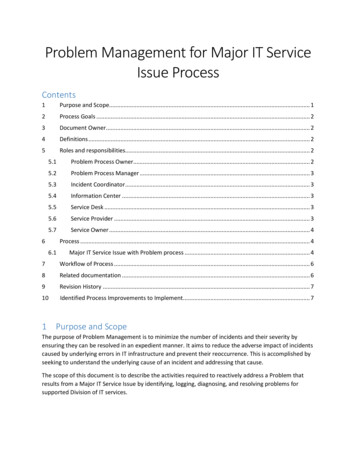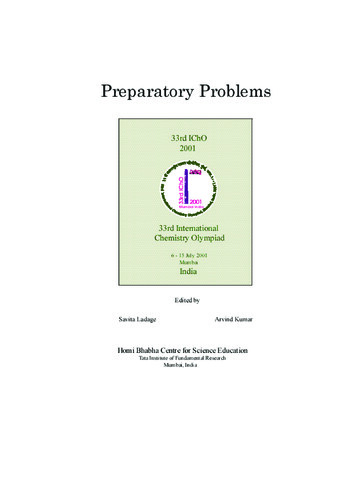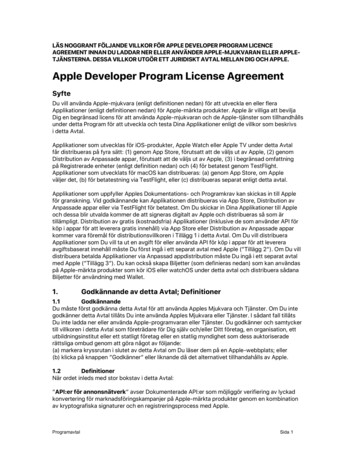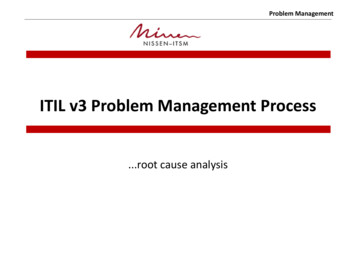
Transcription
Problem Management for Major IT ServiceIssue ProcessContents1Purpose and Scope. 12Process Goals . 23Document Owner. 24Definitions . 25Roles and responsibilities. 25.1Problem Process Owner. 25.2Problem Process Manager . 35.3Incident Coordinator . 35.4Information Center . 35.5Service Desk . 35.6Service Provider . 35.7Service Owner . 46Process . 46.1Major IT Service Issue with Problem process . 47Workflow of Process . 68Related documentation . 69Revision History . 710Identified Process Improvements to Implement . 71 Purpose and ScopeThe purpose of Problem Management is to minimize the number of incidents and their severity byensuring they can be resolved in an expedient manner. It aims to reduce the adverse impact of incidentscaused by underlying errors in IT infrastructure and prevent their reoccurrence. This is accomplished byseeking to understand the underlying cause of an incident and addressing that cause.The scope of this document is to describe the activities required to reactively address a Problem thatresults from a Major IT Service Issue by identifying, logging, diagnosing, and resolving problems forsupported Division of IT services.
While proactive Problem Management is not presently in scope of this document, Service Owners andService Providers may analyze incidents associated with their services and, if a Problem is identified,create and manage a Problem record.2 Process Goals Prevent incidents from reoccurring by identifying and addressing their root causeIdentify and manage sets of incidents related to a Major IT Service IssueMinimize the impact of incidents by documenting and communicating workaroundsComplement the documentation goals of the Major IT Service Issue process3 Document OwnerThe document owner is responsible for ensuring that this document is accurate and up-to-date, followingagreed processes.This document is owned by the Deputy Executive Director within IT Experience & Engagement.4 Definitions Incident: An incident is a disruption in use of an IT service. It can be more specifically considereda breach or potential breach of service level agreement. For services which do not have servicelevel agreements, an incident is when an IT Service is not functioning within expectations orcannot be used. Incidents are typically reported by users, although incidents can also beidentified through monitoring tools or IT employees.IT status: A notification section on the Service Portal (4help.vt.edu) that indicates any outages ordegradations of IT services.Known error: A Problem with a documented root cause and workaround.Outage: A record created in the event of an Outage or Degradation of a core IT service.Problem: A cause of one or more incidents. The cause is not usually known at the time aProblem record is created.Root cause: An incident’s root cause is the fault in the service component that made theincident occur.Workaround: A temporary solution to reduce or eliminate the impact of incident symptoms. Aworkaround can temporarily restore service for a customer even though root cause is not fixed.5 Roles and responsibilities5.1Problem Process OwnerEnsures process documentation is relevant and coordinates updates and communications of theprocess. Maintaining this process documentation.Communicating this process across the Division of IT.Supporting the Problem Process Manager in the operations of this process.
5.2Problem Process ManagerAccountable for the operations of the Problem Management process across the Division of IT. 5.3Serving as an escalation point regarding any Problem Management Process issues or conductingactivities that are part of the process.Relaying needs for process documentation updates to the Problem Process Owner.Coordinating parties involved in handling Problems.Reviewing Problem records in an Open state monthly and notifying Service Owners of when aProblem has been Open for more than a month with no action.Incident CoordinatorThe Incident Coordinator assumes responsibility during a major IT service issue. 5.4Creating an initial Problem record and assigning it to the group whose service triggered a MajorIT Service Issue.Creating an Outage record from the Problem record.Linking incidents to an established Problem and setting the incident(s) state to “AwaitingProblem”.Information CenterVirginia Tech’s 24/7/365 Information Center serves as a point of contact for end users within theUniversity and outside of the University and is responsible for the following activities: 5.5Checking indicators on incidents of active outage and a related Problem.Linking incidents to an established Problem and setting the incident(s) state to “AwaitingProblem”.Service DeskThe Service Desk is a function of 4Help and responsible for the following activities: 5.6Checking indicators on incidents of an active Outage and a related Problem.Linking incidents to an established Problem and setting the incident(s) state to “AwaitingProblem”.Service Provider Checking indicators on incidents of active outage and a related Problem.Linking incidents to an established Problem and setting the incident(s) state to “AwaitingProblem”Identifying Technical Experts to assist with investigating and diagnosing problems.Documenting technical events or information about the Major IT Service Issue in the Problemprocess.Identifying and testing workarounds to mitigate symptoms of ProblemDocumenting workarounds in a ProblemCommunicating workarounds to Problems when the workaround should be sent to users beingimpacted.
5.7Marking a Problem as Known Error when root cause is identified and there is a workaroundposted to the Problem.Resolving incidents in state of ‘Awaiting Problem’ that are associated with ProblemService Owner Linking incidents to an established Problem and setting the incident(s) state to “AwaitingProblem”Attaching (or having a designee attach) the after-action review of the Major IT Service Issue tothe Problem.Closing/resolving a Problem when action has been taken on root cause.Overseeing the Problem process with the Service Provider6 Process6.1Major IT Service Issue with Problem processTriggersInputs Outputs Major IT Service IssueDescription of the interruption orissueIdentification of the serviceexperiencing the issueSymptom information from incidentsConfiguration details from theconfiguration management databaseProblem record description ofProblem and affected serviceDocumentation of technicalinformation related to the ProblemCommunications to submitters ofincidentsDocumented workaroundKnown error (in some cases)Set of affected incidents from theProblemClosed problem records for resolvedproblemsAfter-action review attached toProblem record1. The Incident Coordinator creates a new Problem record and assigns it to the appropriate groupbased on the service (Configuration Item) being affected.2. The Incident Coordinator creates an Outage record (used for IT Status) from the Problem record.This record is used for IT Status updates as per the Major IT Service Issue process.3. The Service Provider assigns the Problem to an individual in their group.4. The Service Provider notifies the Service Owner of the Problem.
5. The Incident Coordinator, Information Center, Service Desk, Service Provider, and Service Ownerlink incidents to the Problem and set the state of each linked incident to “Awaiting Problem”.When a Configuration Item has an active outage, an indicator will show next to theConfiguration Item field, which also indicates there is a Problem record to which the incidentmay be linked.6. The Service Provider (primarily) and Service Owner post work notes to the Problem record,keeping track of technical events, updates, and progress identifying a workaround and potentialcauses of the Problem.7. Once a mitigation for the symptoms resulting from a Problem are discovered, the ServiceProvider and Service Owner test their workaround and, if successful, post that workaround tothe Problem record.8. The Service Provider and Service Owner may communicate the workaround to incidentsubmitters. Communicating the workaround posts the text for the most recently postedWorkaround as Additional comments to all associated incidents.9. The Service Provider and Service Owner may flag a Problem as Known Error if the root cause ofthe Problem is documented and there is a successful workaround to the Problem.10. The Service Provider and Service Owner conduct an after-action review (refer to the Major ITService Issue process) to identify and address the root cause of the Problem. This after-actionreview is then attached to the Problem (most commonly as a PDF).11. The Service Provider and Service Owner resolve all incidents associated with the Problem recordthat are in the “Awaiting Problem” state.12. If the Service Owner deems that action has been taken on the root cause of the Problem toprevent the occurrence of future incidents, then the Service Owner will document the stepstaken to address the root cause in the Close Notes of the Problem record and set the Problemstate to “Closed/Resolved.”
7 Workflow of ProcessThe following diagram is an overview of steps.8 Related documentationThe below processes, policies, or other documentation are related to this process:ProcessMajor ITService IssueProblem ctor, ITE²DeputyExecutiveDirector, ITE²Relationship to this processLocationTriggers this process and suppliesafter-action report referenced inthis process.Provides details and screenshotsfor carrying out some activitieswhich are described at a high levelhere.it.vt.edu/processit.vt.edu/process
9 Revision HistoryVersionVersion 1-2Author(s)David DuckettDateJuly 6, 2018Version 1-1David Duckett, CarolHurley, LucasSullivan, JoyceLandrethMay 16, 201810DescriptionMinor addition that CloseNotes field on Problemrecord should documentsteps taken to resolveroot cause of Problem.Establish a process forthe Division of IT tobenefit from and becomefamiliar with the reactiveProblem Management.Identified Process Improvements to ImplementThe below are improvements identified for consideration during future revisions of this document: Document the proactive component of Problem Management. This would include other meansof Problem detection:o Service Provider/Service Owner/Problem Process Manager observes frequent orrecurring incidents that suggest in an underlying issue.o Service Provider/Service Owner Problem Coordinator is notified by vendor that aproblem exists.o Service Provider/Service Owner sees a trend in incidents that suggests an underlyingissue.Consider formation of a Problem Review Board across the Division to help perform root causeanalysis and more effectively identify workarounds/advance problems to a state of resolution.Use of Impact and Urgency fields for Priority calculations.Create Change Management process and connect with this process for implementing changesintended to resolve root cause.
Problem Management. 10 Identified Process Improvements to Implement The below are improvements identified for consideration during future revisions of this document: Document the proactive component of Problem Management. This would include other means of Problem detection: o Service Provider/Service Owner/Problem Process Manager observes .











